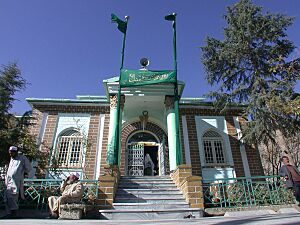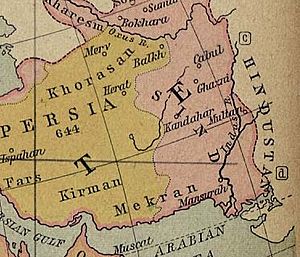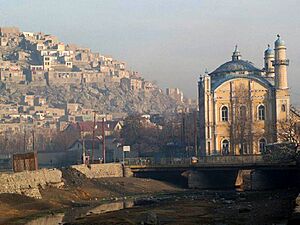History of Arabs in Afghanistan facts for kids

The history of Arabs in Afghanistan goes back more than 1,000 years, starting in the 7th century. Many of the first Arabs who came to Afghanistan slowly lost their original Arabic ways and mixed with the people already living there. However, they are still seen as a separate group of people in Afghanistan today. If someone in Afghanistan has "Sayed" or "Quraishi" in their name, they often say they have Arab family roots.
Contents
First Arabs Arrive in Afghanistan

Around the end of the 7th century, Arab armies from the Umayyad Caliphate entered the area we now call Afghanistan. They had just won a big battle against the Sasanian Empire. The last Sasanian king, Yazdegerd III, ran away towards Central Asia. The Arabs followed him, coming through northeastern Iran and into Herat. They left many soldiers in Herat before moving towards eastern Afghanistan.
Some of these Arabs settled in these new places. They married local people and started to follow new customs. Other groups of Arab soldiers kept moving east. They faced strong resistance in areas like Bamiyan. When they reached Kabul, the Arabs met the Turk Shahi rulers, who had built a long wall around the city to protect it.
Battles in Kabul
The fiercest fighting in Kabul happened in an area called Chahardi. Even today, you can find tombs of Arabs who died in that war in the Darulaman area. A famous Arab leader who died in this war was Shah-do Shamshira. His tomb is near the Kabul River on Asmayee street. Another important commander who fought against the Arab invaders was known as Mazangi. He led the battle of Asmayee, where Shah-Do Shamshira was killed.
There are several places in Kabul where the Arabs fought. After Asmayee, the bloodiest battle was in Alwoden, which is now the Darul Aman area. We don't know many details about this battle, but the Arabs were eventually stopped for a long time.

A famous building in Kabul reminds us of these battles: the tomb of the Shah-e Do Shamshira. This name means The leader with the Two Swords in Persian. It is next to the Shah-Do Shamshira Mosque. This place is near Kabul's market. It was built where an Arab commander died. He fought bravely with a sword in each hand but was killed in battle. The mosque honors his memory. The two-story building was built in the 1920s by the mother of King Amanullah, on the site of one of Kabul's first mosques.
Arabs Settle and Mix
After these battles, the region became part of Khorasan, with its main city in Herat in the west. The Arabs later lost some control but took it back around 750 AD when the Abbasid rulers took over from the Ummayads. By this time, many Arabs started to mix more with the local people. The Arabic way of life in the region began to change a lot.
Arab groups settled in different parts of what is now Afghanistan. This included places like Wardak, Logar, Kabul, Balkh, and the Sulaiman Mountains. Over time, they started to use local customs and languages. Some became more like Persians, while others became more like Afghans, following the Pashtunwali code of life.
One story tells of an Arab named Khalid. He was afraid to go back to Arabia through Persia because he had enemies there. He also didn't want to stay in Kabul under his new leader. So, he went with his family and other Arabs to the Sulaiman Mountains. He married his daughter to an Afghan chief who had become a Muslim. From this marriage came two sons, Lody and Soor, who later became leaders of tribes that still carry their names today. This story was written by Muhammad Qasim Hindu Shah (1560–1620).
Arabic Language Changes
During the time of Ya'qub Saffari, the Arabic language began to lose its importance in the region. However, the Arabs tried to get their influence back. They supported the Samanid rulers of Balkh. In return, the Samanids helped the Abbasid Arabs against the rebellious Saffarid dynasty.
Most of the early Afghan-Arabs slowly stopped speaking Arabic. This is mentioned in a book from the 15th century called Baburnama. It says that the Arabs in Afghanistan had almost lost the Arabic language and instead spoke Persian and Pashto. We don't know the exact number of Arab-Afghans today. An expert in the 18th century guessed there were about 60,000 families.
Second Wave of Arabs
After the Bolshevik Revolution in Russia, many Sunni Arabs living in Bukhara and other parts of Central Asia moved to Afghanistan. They could practice their religion more freely there without fear of being treated badly. One estimate said that about 30,000 Arabs lived in Bukhara in the mid-1800s. The Arabs who came to Afghanistan during this time still spoke some Arabic, unlike the first group of Afghan Arabs.
Some Arabs from this second wave married local people. They started speaking the languages of northern Afghanistan, such as Uzbek, Turkmen, and Persian language. Many settled in Kunduz, Takhar, and Sar-e Pol provinces. Today, these Arabs still see themselves as Arab. However, like the first wave, they have lost their Arabic language and now speak Persian.
Some tribal names, like Qureshi and Shaiboni, are still remembered. But most of these Arabs don't think family trees are very important. Many of these Afghan Arabs work in farming, growing cotton and wheat. Others raise karakul sheep. An expert noted that the Arabs in Central Asia have not been in touch with Arabs from the Middle East since the time of Tamerlane (around 1400).
The main group of Afghan Arabs lives in the Shibarghan provinces. These Afghan Arabs all speak Dari now. They have spoken Dari for as long as they can remember. However, they still say they are Arab. There are other Persian-speaking "Arabs" to the east, between Shebergan, Mazar-i Sharif, Kholm, and Kunduz. They live in small groups. They identify as Arabs mostly because of their tribal names. This might point back to the 7th and 8th centuries, when many Arab tribes from Arabia moved to this area and other parts of Central Asia after the Islamic conquests.
Third Wave of Arabs
During the Soviet–Afghan War in the 1980s, many Arab Muslims came to Afghanistan to help Afghans fight the Soviet Union. Some of these Arabs stayed after the Soviets left and were given Afghan citizenship. Others married local Afghans, while some even brought their families to Afghanistan.
Kandahar has a small Arab cemetery. Over 70 graves there belong to Arab members of al-Qaeda who were killed during the U.S. War on Terror. These Arabs are honored by the Taliban and their supporters as shahid (meaning martyrs).
Arab Groups in Different Regions
Balkh Province Arabs
About 900 families live in Khoshal Abad and Yakhdan villages in the Dawlat Abad district of Balkh Province. These villagers can trace their family history back to the time of the third caliph, Uthman, in the 7th century. These families mostly work in farming and carpet weaving.
Most Arabs in Balkh Province speak Arabic as their first language and Dari as a second language. Some older people never learned to speak Dari or Pashto, which are Afghanistan's two official languages. However, many younger people are learning Dari in school and are forgetting their Arabic. About 40 percent of them can no longer speak Arabic. Many of their old customs have been forgotten or are not important to the younger generation, who feel more connected to Afghanistan. Arabs who settled in northern Balkh province are worried that their culture is disappearing as more people adopt Afghanistan's language and traditions. Arabs are a smaller group in the town and district of Kholm. Many identify themselves as ethnic Arabs, even though no one actually speaks Arabic there.
Jowzjan Province Arabs
There are about 1,000 families in Hassanabad of Shebarghan, the capital of Jowzjan Province, and in Sultan Arigh village of Aqcha district. These families identify themselves as Arabs. However, none of them have spoken Arabic in their living memory. Dari is their native language.
Nangarhar Province Arabs
Many Arab families live in Nangarhar city, Jalalabad. Most people living in the villages claim to have Arab family roots, from places like Iraq or Egypt. The majority have lost their original language and now speak Dari mixed with Pashto, which has created a unique accent.
See also
- Arab diaspora
- Central Asian Arabic
- Farooqi
- Hashemi
- Muslim conquests of Afghanistan
- Pashtunization
- Arab-Persians
- Persianization
- Sayyid
- Siddiqui
- Qureshi
|

